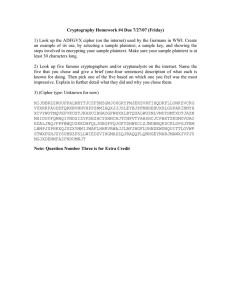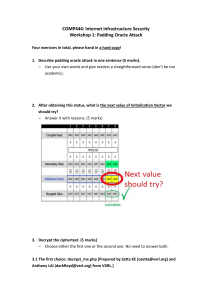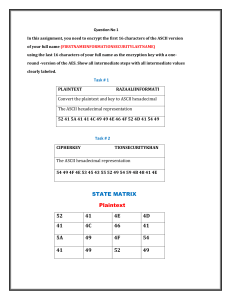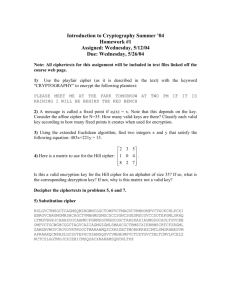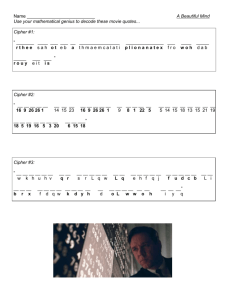MonoAlphapetic substitution cryptanalysis example
advertisement
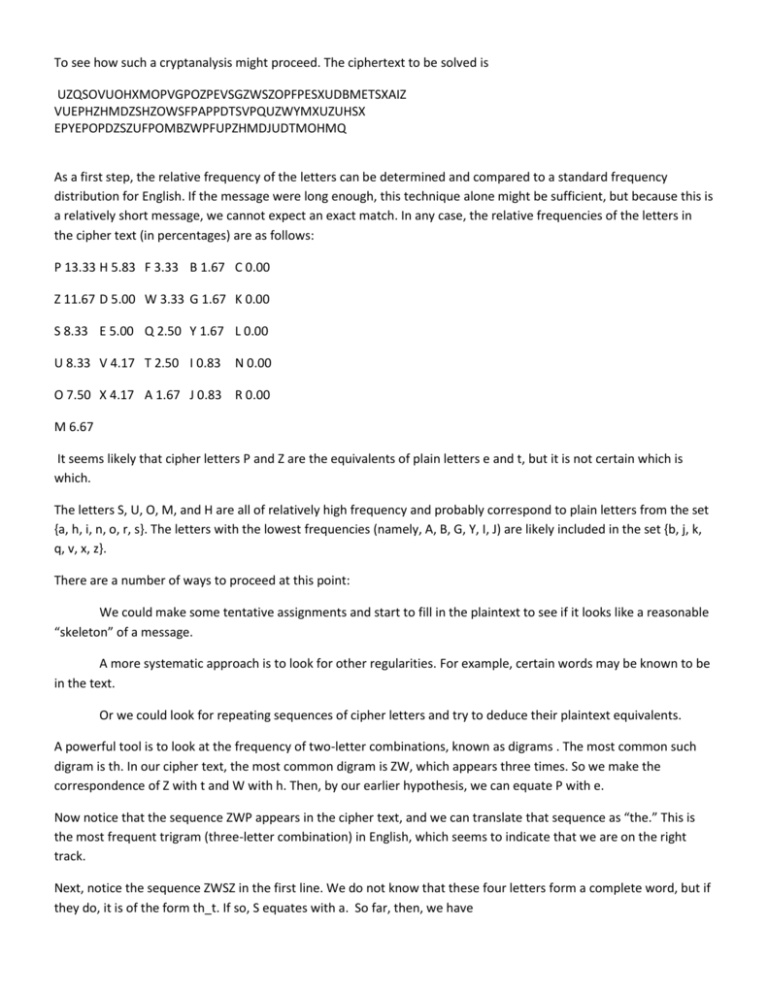
To see how such a cryptanalysis might proceed. The ciphertext to be solved is
UZQSOVUOHXMOPVGPOZPEVSGZWSZOPFPESXUDBMETSXAIZ
VUEPHZHMDZSHZOWSFPAPPDTSVPQUZWYMXUZUHSX
EPYEPOPDZSZUFPOMBZWPFUPZHMDJUDTMOHMQ
As a first step, the relative frequency of the letters can be determined and compared to a standard frequency
distribution for English. If the message were long enough, this technique alone might be sufficient, but because this is
a relatively short message, we cannot expect an exact match. In any case, the relative frequencies of the letters in
the cipher text (in percentages) are as follows:
P 13.33 H 5.83 F 3.33 B 1.67 C 0.00
Z 11.67 D 5.00 W 3.33 G 1.67 K 0.00
S 8.33 E 5.00 Q 2.50 Y 1.67 L 0.00
U 8.33 V 4.17 T 2.50 I 0.83
N 0.00
O 7.50 X 4.17 A 1.67 J 0.83 R 0.00
M 6.67
It seems likely that cipher letters P and Z are the equivalents of plain letters e and t, but it is not certain which is
which.
The letters S, U, O, M, and H are all of relatively high frequency and probably correspond to plain letters from the set
{a, h, i, n, o, r, s}. The letters with the lowest frequencies (namely, A, B, G, Y, I, J) are likely included in the set {b, j, k,
q, v, x, z}.
There are a number of ways to proceed at this point:
We could make some tentative assignments and start to fill in the plaintext to see if it looks like a reasonable
“skeleton” of a message.
A more systematic approach is to look for other regularities. For example, certain words may be known to be
in the text.
Or we could look for repeating sequences of cipher letters and try to deduce their plaintext equivalents.
A powerful tool is to look at the frequency of two-letter combinations, known as digrams . The most common such
digram is th. In our cipher text, the most common digram is ZW, which appears three times. So we make the
correspondence of Z with t and W with h. Then, by our earlier hypothesis, we can equate P with e.
Now notice that the sequence ZWP appears in the cipher text, and we can translate that sequence as “the.” This is
the most frequent trigram (three-letter combination) in English, which seems to indicate that we are on the right
track.
Next, notice the sequence ZWSZ in the first line. We do not know that these four letters form a complete word, but if
they do, it is of the form th_t. If so, S equates with a. So far, then, we have
UZQSOVUOHXMOPVGPOZPEVSGZWSZOPFPESXUDBMETSXAIZ
t a
e
e te
a that
e e a
a
VUEPHZHMDZSHZOWSFPAPPDTSVPQUZWYMXUZUHSX
e t
ta t ha e ee
a e
th
t
a
EPYEPOPDZSZUFPOMBZWPFUPZHMDJUDTMOHMQ
e
e e tat
e
the
t
Only four letters have been identified, but already we have quite a bit of the message. Continued analysis of
frequencies plus trial and error should easily yield a solution from this point. The complete plaintext, with spaces
added between words, follows:
it was disclosed yesterday that several informal but
direct contacts have been made with political
representatives of the Viet cong in Moscow

